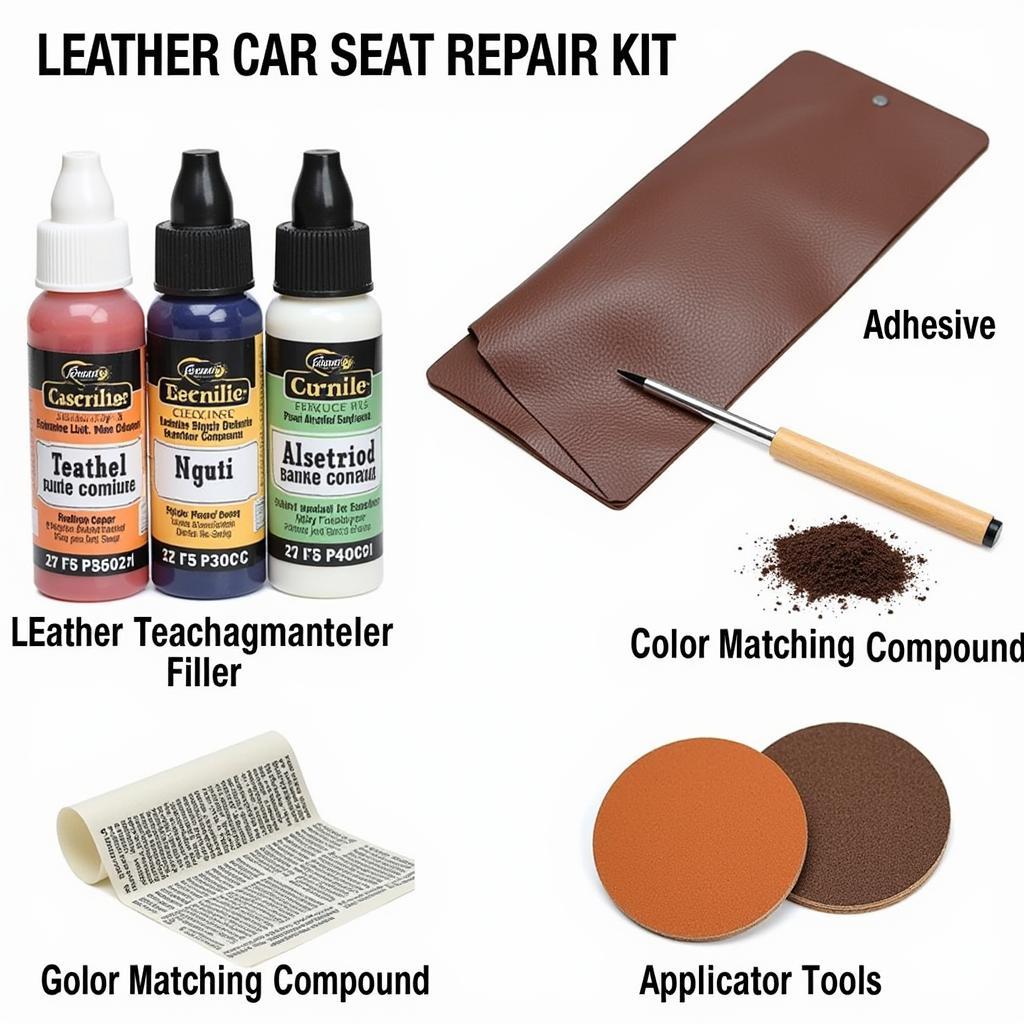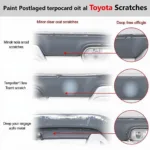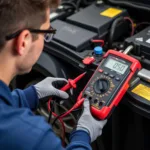Ripped leather car seats can be an eyesore and diminish the overall aesthetic of your vehicle. Luckily, repairing a leather car seat rip is often easier than you think, and you can achieve professional-looking results without breaking the bank. This guide will provide a comprehensive walkthrough on how to repair a leather car seat rip, from assessing the damage to selecting the right repair kit and executing the repair like a pro.
Assessing the Damage: Know Your Rip
Before you rush into buying a repair kit, carefully examine the rip in your leather car seat. Is it a small tear, a large gash, or a series of cracks? The severity of the damage will dictate the type of repair method and materials you’ll need. For minor scratches and scuffs, a simple leather conditioner might suffice. However, for deeper rips and tears, a leather repair kit is essential. Also, consider the location of the rip. A rip on a high-stress area like the driver’s seat bolster will require a more robust repair than a rip on a less-used area.
What type of leather is your car seat made of? Is it genuine leather, bonded leather, or faux leather? Knowing the type of leather will help you choose the right repair kit and ensure compatibility. Genuine leather is the most durable and easiest to repair, while bonded and faux leathers can be more challenging.
Gathering Your Repair Arsenal: The Right Tools for the Job
Once you’ve assessed the damage, it’s time to gather your repair tools. A comprehensive leather repair kit should include the following:
- Leather filler: This is used to fill in deep rips and tears, creating a smooth surface for the repair compound.
- Leather adhesive: This is used to bond the edges of the rip together and secure the repair patch.
- Color matching compound: This is used to blend the repaired area seamlessly with the surrounding leather.
- Grain paper: This is used to imprint a realistic grain pattern onto the repaired area, matching the original texture.
- Applicator tools: These include spatulas, brushes, and sponges for applying the repair materials.
You can find high-quality leather repair kits online or at auto parts stores. Make sure to choose a kit that is specifically designed for leather car seats.
Step-by-Step Guide: How to Repair a Leather Car Seat Rip
Now, let’s dive into the actual repair process. Follow these steps carefully for optimal results:
- Clean the area: Thoroughly clean the ripped area with a leather cleaner and a microfiber cloth. This removes dirt, grease, and grime that can interfere with the adhesion of the repair materials.
- Prepare the rip: If the rip has frayed edges, carefully trim them with a sharp pair of scissors or a razor blade. This creates a clean edge for the repair compound to adhere to.
- Apply the leather filler: If the rip is deep, apply leather filler to the damaged area using a spatula. Build up the filler in thin layers, allowing each layer to dry completely before applying the next.
- Apply the adhesive: Apply a thin layer of leather adhesive to the edges of the rip and bring them together. Hold the edges together firmly for a few minutes to ensure a strong bond.
- Apply the color matching compound: Once the adhesive has dried, apply the color matching compound to the repaired area. Use a sponge or brush to blend the compound seamlessly with the surrounding leather.
- Apply the grain paper: While the color matching compound is still wet, place a piece of grain paper over the repaired area. Press firmly and evenly to imprint the grain pattern onto the compound.
- Allow to dry: Allow the repair to dry completely according to the instructions on the repair kit. Avoid touching or disturbing the repaired area during the drying process.
Maintaining Your Repaired Leather Car Seats
Once you’ve successfully repaired your leather car seat rip, proper maintenance is crucial to prolong the lifespan of the repair and prevent further damage.
- Regular Cleaning: Clean your leather car seats regularly with a dedicated leather cleaner and conditioner. This will help keep the leather supple and prevent it from drying out and cracking.
- UV Protection: Protect your leather car seats from direct sunlight, which can cause fading and cracking. Use a sunshade or park in shaded areas whenever possible.
- Avoid Harsh Chemicals: Avoid using harsh chemicals or abrasive cleaners on your leather car seats, as these can damage the finish.
“Preventive maintenance is key to preserving the integrity of your leather car seats,” says renowned automotive upholstery expert, Jonathan Davies. “Regular cleaning and conditioning can significantly extend the life of your leather and minimize the risk of rips and tears.”
Conclusion: A Stitch in Time Saves Nine
Repairing a leather car seat rip is a manageable DIY project that can save you money and restore the beauty of your vehicle’s interior. By following the steps outlined in this guide and investing in a quality repair kit, you can achieve professional-looking results and enjoy your rejuvenated car seats for years to come. Remember, addressing a small rip promptly can prevent it from becoming a larger, more costly problem down the line. How to repair a leather car seat rip doesn’t have to be a daunting task.
FAQ
- Can I repair a rip on any type of leather car seat? Most types of leather can be repaired, but genuine leather is typically the easiest. Bonded and faux leather can be more challenging.
- How long does the repair process typically take? The repair process can take anywhere from a few hours to a day, depending on the size and severity of the rip and the drying time of the repair materials.
- How much does a leather repair kit cost? Leather repair kits range in price from $20 to $50, depending on the brand and the included components.
- Can I repair a rip on a heated car seat? Yes, you can repair a rip on a heated car seat, but make sure the heating element is turned off and the seat is cool to the touch before starting the repair.
- How can I prevent future rips in my leather car seats? Regular cleaning and conditioning, along with UV protection, can help prevent future rips and tears.
Common Scenarios and Questions
- Scenario: My cat scratched my leather car seat. Can I repair this? Yes, minor scratches can often be repaired using a leather repair kit or even just a leather conditioner.
- Question: What if the rip is very large? For very large rips, it might be best to consult a professional upholstery repair service.
Further Reading
For more information on car maintenance and repair, check out our other articles on CarRepairOnline:
- How to Detail Your Car’s Interior
- Choosing the Right Car Seat Covers
Need help? Contact us via WhatsApp: +1(641)206-8880 or Email: [email protected]. Our 24/7 customer service team is here to assist you.



